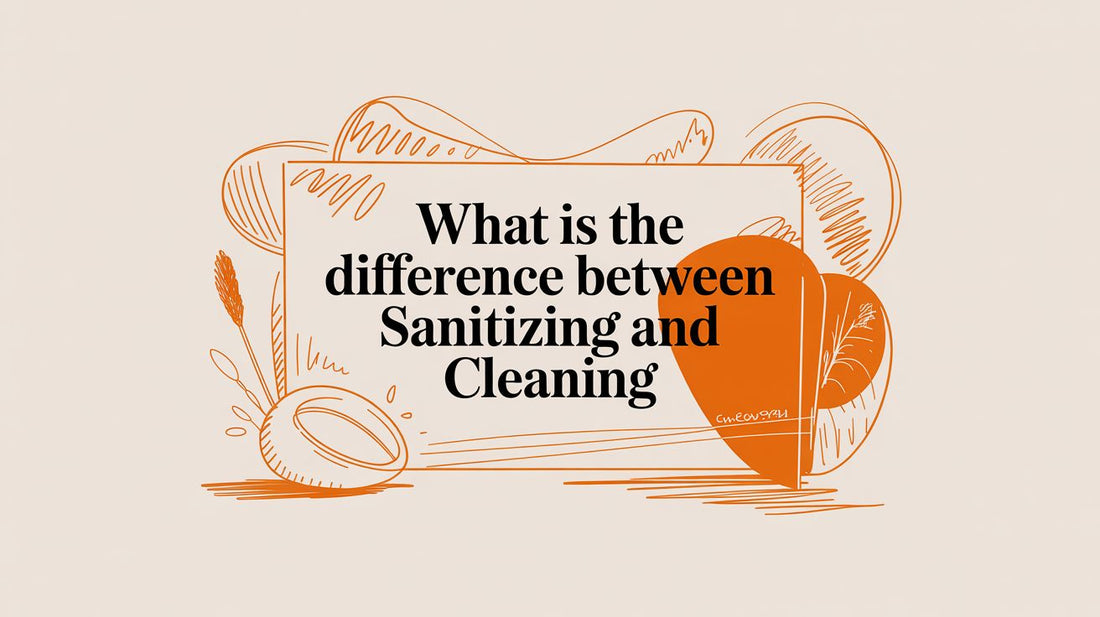
what is the difference between sanitizing and cleaning
Share
You've probably heard the terms "cleaning" and "sanitizing" used interchangeably, but in the world of true hygiene, they mean very different things. Getting this distinction right is the first step to creating a genuinely healthy space, whether it's your kitchen counter or a child's playroom.
So, what's the real story? It boils down to this: Cleaning is about what you can see, while sanitizing is about what you can't.
Defining the Key Differences
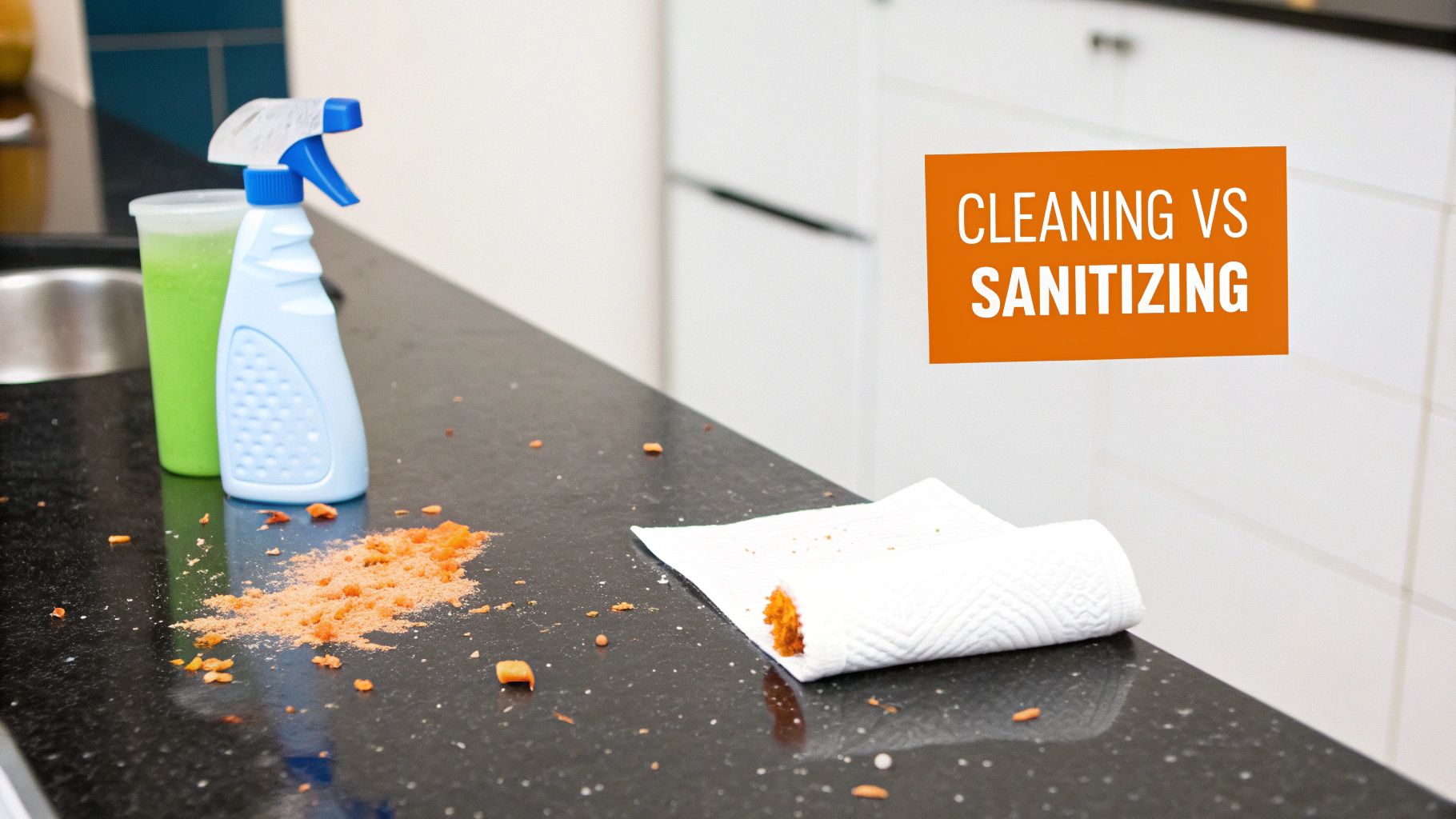
Think of it as a mandatory two-step process. Cleaning always comes first. It’s the physical act of using soap, water, and some elbow grease to scrub away visible dirt, crumbs, and grime. This action lifts and removes a good chunk of germs along with the mess.
Sanitizing is the second, crucial step. After a surface looks clean, a sanitizer gets to work on a microscopic level. Its job is to dramatically reduce the number of lingering bacteria and other microorganisms to a level deemed safe by public health standards. You can’t sanitize a dirty surface—grime acts like a shield, preventing the sanitizer from reaching the germs it needs to eliminate.
To really nail down the difference, let's look at them side-by-side.
Cleaning vs. Sanitizing At a Glance
This quick table breaks down the core functions and outcomes of each process.
| Attribute | Cleaning | Sanitizing |
|---|---|---|
| Primary Goal | Remove visible dirt, soil, and debris | Reduce harmful bacteria to a safe level |
| Mechanism | Physical removal using soap, water, and friction | Chemical process to lower microbial count |
| Target | Surface-level grime, food particles, and dust | Microscopic bacteria and other microorganisms |
| Outcome | A visibly clean surface | A surface with a significantly reduced bacterial load |
| Required Step | Always the first step in a hygiene process | The second step, performed after cleaning |
| Common Tools | Soaps, detergents, sponges, cloths, water | EPA-registered sanitizing sprays, wipes, bleach solutions |
As you can see, these aren't competing methods; they're partners in a sequence. One simply can't be effective without the other.
Key Takeaway: You cannot sanitize a dirty surface. Cleaning removes the physical barrier of grime, allowing sanitizers to make direct contact with germs and effectively reduce them to safe levels. One process addresses what you see; the other addresses what you don't.
How Cleaning and Sanitizing Actually Work
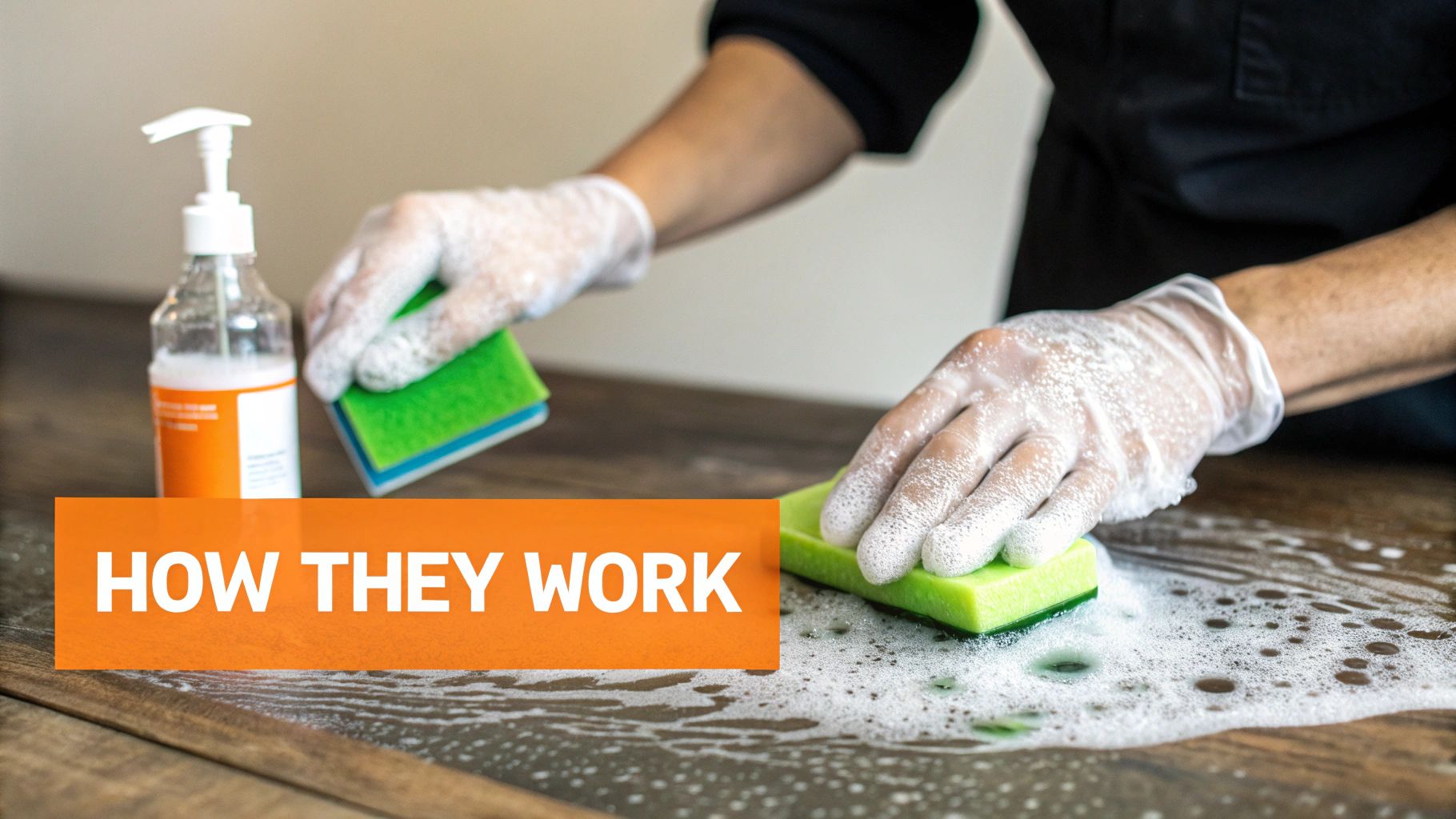
To really get the difference between cleaning and sanitizing, it helps to look at what's happening on a scientific level. They might seem similar, but each process tackles a completely different problem with its own unique approach.
Cleaning is all about physical removal, driven by some pretty clever chemistry. When you grab a bottle of soap or detergent, you’re using molecules called surfactants. These guys have a cool double life: one end of the molecule loves water, while the other end is drawn to oil and grease.
This unique structure lets the surfactants grab onto dirt and grime, lifting them right off the surface. Add a little scrubbing and some water, and those trapped particles get washed down the drain, leaving things looking visibly clean.
The Science of Sanitizing
Sanitizing, on the other hand, is a chemical fight on a microscopic scale—and it should always happen after you’ve cleaned. Sanitizers work by going after the cells of microorganisms like bacteria.
The most common sanitizing agents get the job done in a few key ways:
- Disrupting Cell Membranes: Chemicals like alcohol can dissolve the fatty outer layer of a bacterial cell, causing it to fall apart and die.
- Denaturing Proteins: Agents like chlorine compounds and hypochlorous acid (HOCl) work by changing the shape of essential proteins and enzymes inside a microbe. This makes them useless and neutralizes the threat. If you're curious about this powerful yet gentle sanitizer, you can explore the science behind HOCl cleaners in our detailed guide.
This difference is absolutely critical in places where stopping infection is a top priority. Sanitizing is designed to reduce the number of germs to a safe level—we're talking a 99.9% reduction—while cleaning is the crucial first step that removes the dirt and grime that germs use to hide.
Why Contact Time Is Critical
For a sanitizer to do its job, it needs time. This is called contact time or dwell time—it's the amount of time a sanitizer has to stay wet on a surface to actually kill the germs it promises to.
If you spray a sanitizer and wipe it away immediately, you're likely not sanitizing at all. The active ingredients need several minutes, as specified on the product label, to penetrate and neutralize microorganisms.
For instance, a product might need a surface to stay visibly wet for three to five minutes to work as advertised. Reading and following the label instructions is non-negotiable if you want a truly hygienic result. It's the only way to be sure you're not just wiping away dirt, but actually knocking down the harmful germs.
Why Cleaning Must Come Before Sanitizing
Here’s one of the most important rules in hygiene, and it’s non-negotiable: you can’t effectively sanitize a dirty surface. Trying to do so is like trying to paint a dusty wall—the new coat just won’t stick, and you’ll be left with a mess. This simple two-step process is the absolute foundation of real cleanliness, and if you skip the first step, the second one is pretty much useless.
Just picture your kitchen counter after making dinner. It’s probably covered in crumbs, a little grease, and maybe some food residue. All that organic stuff creates a physical shield, often called a biofilm, that stops sanitizing solutions from ever reaching the harmful germs hiding underneath. Your sanitizer might hit the top layer of grime, but the microbes are still safe and sound, ready to multiply.
How Dirt Deactivates Sanitizers
Beyond just forming a physical barrier, dirt and grime can actually neutralize the active ingredients in your sanitizer. Many common sanitizers, including those with chlorine compounds or alcohol, lose their punch when they come into contact with organic material. The chemicals essentially get "used up" reacting with the dirt instead of the germs.
This means even if you douse a dirty surface until it’s soaking wet, you aren't actually knocking the germ count down to a safe level. You’re just spreading around a weakened, ineffective solution on top of a mess.
The Golden Rule: Cleaning removes the soil and organic matter that germs use to hide and thrive. Only after this barrier is gone can a sanitizer make direct, effective contact with microorganisms to reduce them to safe levels.
The Real-World Impact of a Two-Step Process
This principle is so critical that it fuels a massive global industry. The worldwide cleaning services market was valued at around USD 424.06 billion in 2024, a number that shot up thanks to a heightened public awareness of hygiene. This growth just proves how vital it is to clean surfaces thoroughly before even thinking about sanitizing. You can dig into more insights on this trend and its effect on public health protocols at Fortune Business Insights.
Whether it’s a food prep surface in your kitchen or a high-touch doorknob in an office, the sequence for preventing infection is always the same.
A Simple Analogy:
- Cleaning is like sweeping the floor. You get rid of all the visible dirt, dust, and debris first.
- Sanitizing is like mopping with a disinfectant. You apply the solution to the now-cleared floor to neutralize what you can't see.
If you didn’t sweep first, you’d just be pushing muddy water around. The exact same logic applies here. Always start with soap and water to clear the way, then follow up with a quality sanitizer to finish the job right.
When to Clean and When to Sanitize in Your Home
Understanding the theory is one thing, but knowing when to actually apply it in your own home is what truly matters. Making the right call between cleaning and sanitizing depends entirely on the situation—what's the surface, how is it used, and what's the real risk of germs? A simple wipe-down isn't always enough, but you definitely don't need to sanitize every square inch of your house either.
The trick is to think strategically about where germs are most likely to set up camp and cause trouble. High-traffic, high-touch areas are the prime candidates for the full two-step clean-and-sanitize process. Other, lower-risk surfaces often just need a good old-fashioned cleaning to look their best and stay hygienic.
Kitchen Counters and Cutting Boards
Your kitchen is ground zero for potential cross-contamination, especially after you've been working with raw meat, poultry, or fish. These surfaces demand more than just a quick wipe.
Action: Always clean first, then sanitize. After you’re done with food prep, especially with raw ingredients, you have to clean the counter and cutting board with hot, soapy water. This gets rid of all the visible gunk and grease. Only then should you apply a sanitizer, letting it sit for its required contact time before rinsing (if needed) and letting it air dry. This two-step method is completely non-negotiable for food safety.
High-Touch Points: Doorknobs and Light Switches
Just think about how many times a day your family touches doorknobs, light switches, cabinet handles, and remote controls. These spots are basically germ superhighways, making it incredibly easy to pass microbes from one person to another.
Action: Clean daily, sanitize frequently. For everyday upkeep, wiping these surfaces down with a simple all-purpose cleaner does the job. But you should really be sanitizing them at least a few times a week—and bump that up to daily if someone in the house is sick. This keeps the germ count low and helps break the chain of transmission.
This simple decision tree helps visualize the process: always start by assessing if a surface is dirty.
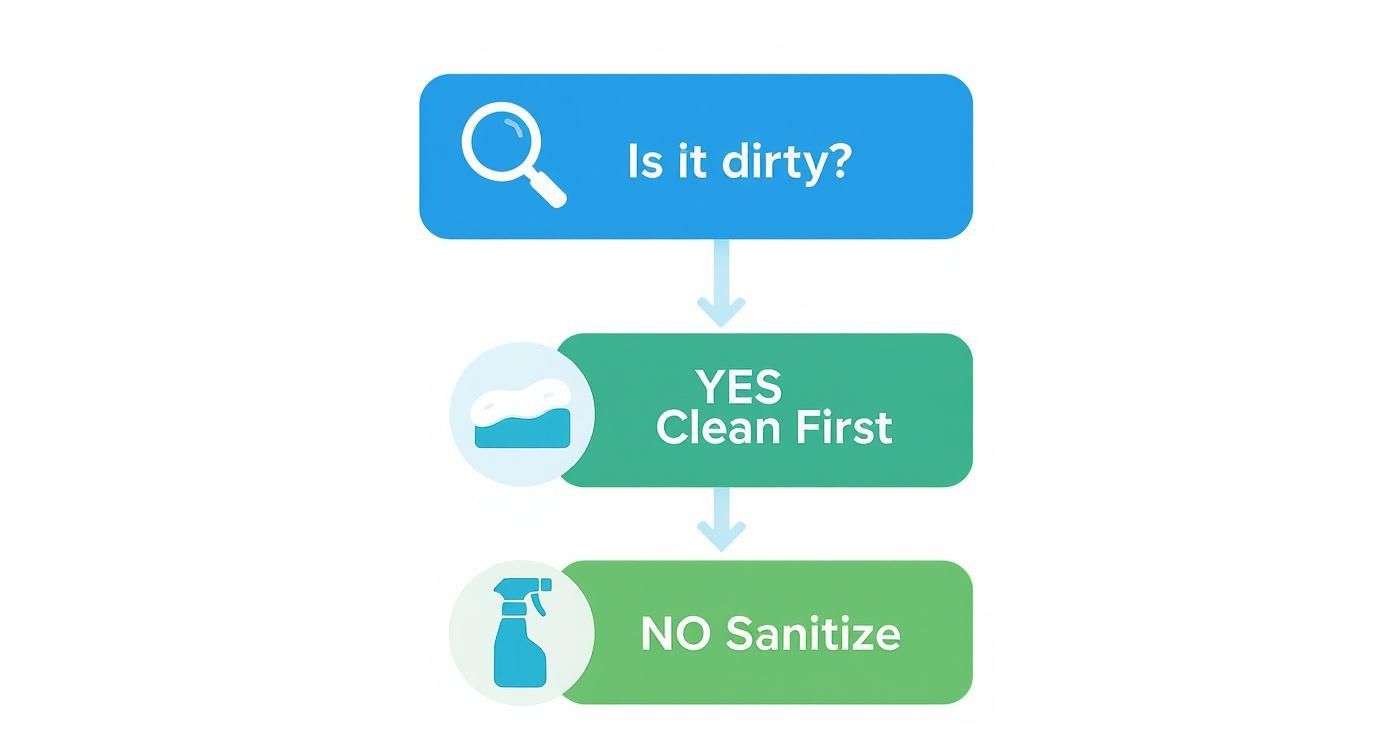
This visual guide reinforces the golden rule: you can't effectively sanitize a dirty surface. Cleaning is always the essential first step.
Children's Toys and Pet Areas
Items that go straight into a child's mouth or areas where your pets eat and play need special attention. The goal here is to keep things hygienic without introducing a bunch of harsh chemicals.
- Children’s Toys: Non-porous plastic toys should be cleaned regularly with soap and water. It's a good idea to sanitize them weekly or after a playdate, ideally with a gentle, food-safe sanitizer.
- Pet Bowls and Mats: These need to be cleaned daily with hot, soapy water to wash away food residue and saliva. Sanitize them at least once a week to control bacteria that can affect both your pets and your family. If you're looking for a gentle yet powerful option, our guide on why HOCL is best for pets offers some great insights into pet-safe sanitizing.
Key Insight: The goal isn’t to create a sterile, bubble-wrapped environment. It's about reducing the risk of illness. Focus your sanitizing efforts on the areas that pose the highest threat of germ transmission and stick to regular cleaning for everything else.
To make it even simpler, here's a quick guide to help you decide what to do and when.
Decision Guide for Common Household Areas
This table breaks down the best course of action for different spots around your home, helping you protect your family without going overboard.
| Area/Item | Primary Action | Why It's Necessary |
|---|---|---|
| Kitchen Sink | Clean and Sanitize | Constantly exposed to food particles and moisture, making it a prime spot for bacteria. |
| Living Room Coffee Table | Clean | Regular cleaning removes dust and spills. Sanitize only if someone is sick. |
| Bathroom Faucets | Clean and Sanitize | A high-touch surface in a high-germ area that needs frequent attention. |
| Pet Food Bowls | Clean and Sanitize | Daily cleaning is a must; weekly sanitizing prevents harmful bacterial buildup. |
| Kids' Plastic Toys | Clean and Sanitize | Regularly cleaned, but sanitized after playdates or illness to stop germ spread. |
| Bedroom Dresser | Clean | Dusting and wiping are usually sufficient unless it becomes a high-contact surface. |
| Remote Controls | Clean and Sanitize | One of the most-touched items in any home. Sanitize weekly, or daily if sickness is present. |
By targeting your efforts where they matter most, you can maintain a home that is both clean and healthy, giving you total peace of mind.
Choosing the Right Cleaning and Sanitizing Products
Walking down the cleaning aisle can be a bit dizzying. You're faced with a wall of products, each one promising a spotless, germ-free home. But what do you really need? The key is knowing when to clean and when to sanitize, because they're two very different jobs requiring two very different tools.
Are you just trying to wipe up some spilled coffee and crumbs, or are you trying to knock down the number of germs on your kitchen counter after handling raw chicken? Your answer determines which bottle you should reach for.
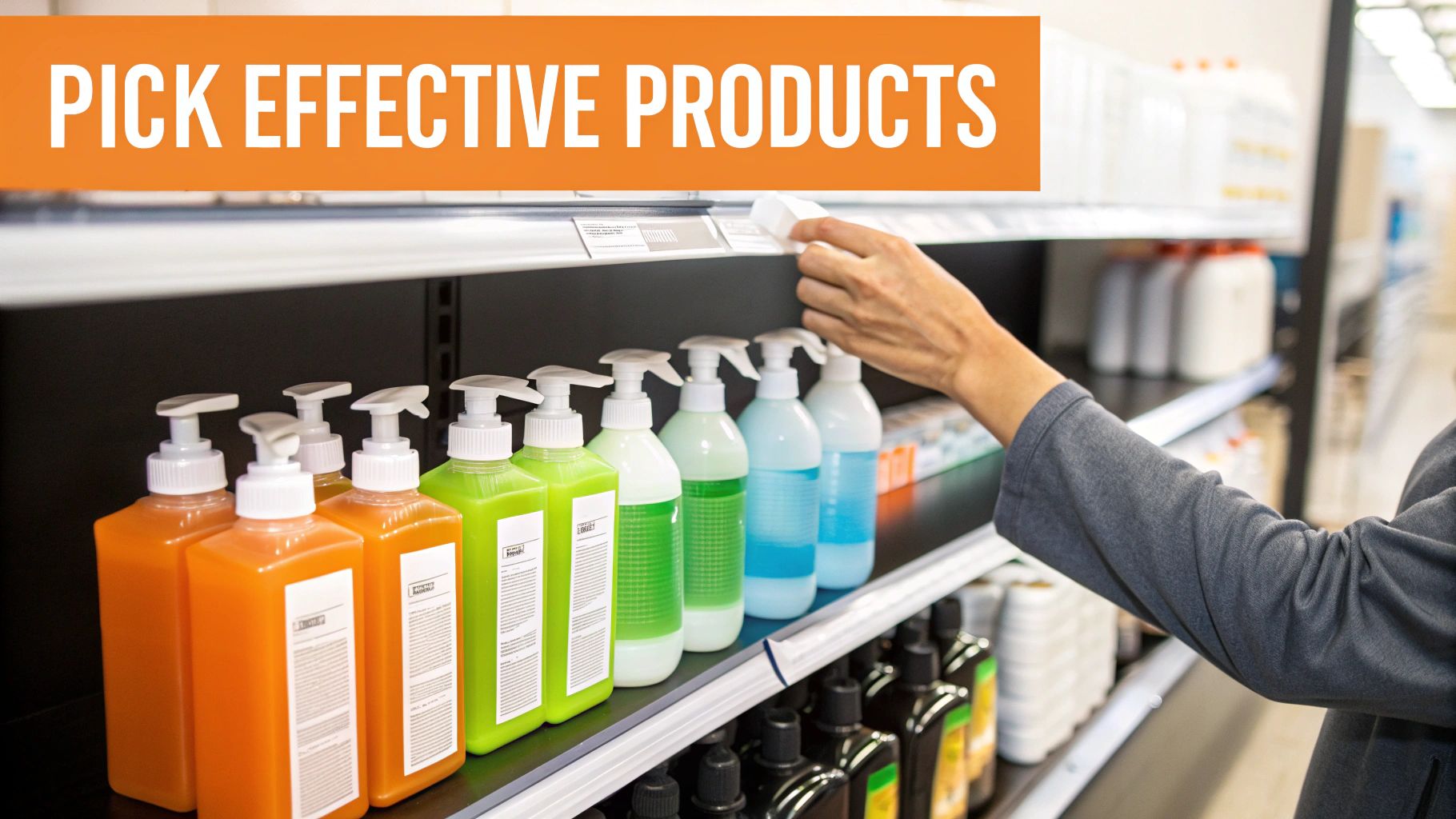
For the daily grime and visible messes, a simple cleaner is your best friend. These products are all about lifting dirt off surfaces so you can wipe it away.
- Soaps and All-Purpose Cleaners: Think of these as your first line of defense. They use surfactants to break the bonds between dirt, grease, and your countertops, making cleanup a breeze. They’re perfect for floors, windows, and most everyday spills where the germ risk is low.
Sanitizers, on the other hand, have a much more specific mission: to drastically reduce the number of bacteria on a surface that's already clean. This is where you bring in things like alcohol-based solutions or chlorine bleach to chemically neutralize microscopic threats.
How to Read Product Labels
Your best tool for choosing the right product isn’t a sponge or a cloth—it’s the label on the bottle. It tells you exactly what the product is meant to do and how to use it without causing harm.
If a product claims to sanitize or disinfect, the first thing you should look for is an EPA registration number. This is your proof that the government has verified the product's claims to kill germs. No number? It's just a cleaner.
The label will also specify the contact time, which is the amount of time the surface needs to stay visibly wet for the sanitizer to actually do its job. If you spray and wipe immediately, you’re probably just cleaning, not sanitizing.
This kind of consumer awareness is making big waves. In 2023, the global market for cleaning and hygiene products hit around USD 153.58 billion, and it's set to keep growing as more people prioritize health. You can dig into more on this trend and the shift towards sustainable solutions at Grand View Research.
Exploring Eco-Friendly Alternatives
As we've all become more conscious of what we bring into our homes, the demand for effective but gentler alternatives has skyrocketed. People want powerful results without the harsh chemicals, leading to some incredible innovations in eco-friendly options that truly work.
One of the most impressive and gentle alternatives out there is hypochlorous acid (HOCl). It’s a powerhouse sanitizer that’s also non-toxic and eco-friendly, making it a fantastic choice for homes with kids, pets, or anyone with chemical sensitivities.
HOCl works by oxidizing the cell structure of microbes, basically neutralizing them on contact without leaving any harsh chemical residues behind. While these smarter, nature-inspired formulas might have a different price point than the cheap chemical cleaners, their safety and performance offer incredible value. If you're curious about what goes into making them, this article does a great job of explaining why HOCl cleaners are priced differently than their toxic counterparts.
Ultimately, choosing a product like this means you don’t have to compromise. You can maintain a truly hygienic home that’s also completely safe for your family and better for the planet.
Have More Questions? Let's Clear Things Up
Even with a solid grasp of the basics, a few practical questions always pop up about how cleaning and sanitizing work in the real world. Let's tackle some of the most common ones to make sure you have all the answers you need to keep your space truly healthy.
What Is the Difference Between Sanitizing and Disinfecting
You’ll hear these two terms thrown around, often interchangeably, but they aren’t the same thing. The real difference comes down to their germ-killing strength and what they’re designed to eliminate.
- Sanitizing is all about reducing the number of bacteria on a surface to a safe level, according to public health standards. The CDC’s benchmark for this is eliminating 99.9% of bacteria. This is your go-to standard for any surface that comes into contact with food.
- Disinfecting takes it a step further. It involves using more powerful chemicals to kill nearly 100% of germs—and this includes not just bacteria but specific viruses and fungi, too. Disinfecting is the priority in hospitals or at home when someone is sick.
Here’s a simple way to think about it: You sanitize your kitchen counters before prepping a meal, but you disinfect the bathroom after a family member has had the flu.
How Often Should I Sanitize High Touch Surfaces
For those high-traffic spots like doorknobs, light switches, remotes, and phones, the right sanitizing schedule really depends on what’s happening in your home. The key is to have a routine that you can easily adapt when needed.
Under normal, healthy circumstances, hitting these areas two to three times per week is plenty to keep germs in check. However, there are definitely times when you need to ramp things up.
Key Recommendation: If someone in your house gets sick with something contagious like a cold or the flu, switch to daily sanitizing for all high-touch points immediately. It’s a simple step that makes a huge difference in stopping germs from spreading to everyone else.
Are Natural Alternatives Like Vinegar Effective Sanitizers
It’s great to look for natural solutions, but while some are fantastic cleaners, they just don't make the cut for sanitizing. Things like white vinegar and tea tree oil have some antimicrobial properties, but they are not registered with the EPA as sanitizers.
That’s a critical distinction. For a product to be officially called a sanitizer, it has to prove it can kill 99.9% of specific bacteria within a certain timeframe. Homemade and natural recipes haven't passed that rigorous test, so you can't count on them to get pathogens down to a safe level.
If you want real sanitizing power without harsh chemicals, you need a solution that’s backed by science.
- Vinegar: It’s an amazing natural cleaner and degreaser because of its acidity. But it just isn't strong enough to be a sanitizer.
- Tea Tree Oil: While it shows some antibacterial effects in a lab, there's no proof or regulation confirming it works effectively on your household surfaces.
- Hypochlorous Acid (HOCl): This is where you get the best of both worlds. HOCl is a nature-inspired, eco-friendly option that is an EPA-registered sanitizer. It’s tough on germs but so gentle you can use it around kids and pets.
It all comes down to using the right tool for the job. Vinegar is perfect for making your windows sparkle, but it’s not what you should reach for to make your cutting board food-safe. For the jobs that really count, stick with proven, registered sanitizers.
Ready to simplify your routine with a sanitizer that's both powerful and eco-friendly? OrbitEnviro offers science-backed hypochlorous acid (HOCl) solutions perfect for every high-touch surface in your home, school, or gym. Keep your spaces safe and fresh without harsh chemicals by visiting https://www.orbitenviro.com to explore our multi-use cleaners.
Article created using Outrank
